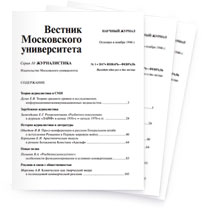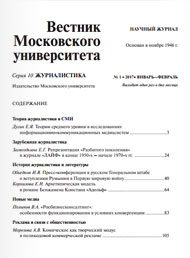Issue
№ 5
' 2022
Content:
-
History of Journalism
«Attempts to Establish a Central Physical Culture and Sport Publishing House in the 1920s »
The article deals with an extremely confusing issue about the history of the formation of a centralized specialized publishing house for physical culture and sport during the 1920s, which has not been practically raised so far in Russian and foreign research literature. Such a publishing house was necessary for the leadership of Soviet physical education as one of the main tools for organizational and outreach activities, designed to direct the lives of millions of athletes in the direction necessary for the state. The article is aimed at destroying the widely accepted but erroneous opinion that only the history of the Physical Culture and Sport publishing house established in 1923 deserves scholarly attention. On the basis of archival documents, many of which are introduced into scientific circulation for the first time, the article examines a whole sequence of emergence and termination of a number of publishing projects created under the auspices of various organizations which headed Soviet physical education. The author used the documents containing information about the work of these organizations and their interaction with publishing agencies, which are stored in the funds of the state archives GARF (State Archive of the Russian Federation) and RGASPI (Russian State Archive of Socio-Political History). Also used were publications from sports periodicals published in the 1920s. The author set himself the goal of recreating the chronology of the publishing process in the field of sports up to the emergence of the Joint-Stock Publishing Company “Physical Culture and Sport” and to analyze a complex set of factors that influenced the operation of this and other publishing houses.
Keywords: Soviet journalism of the 1920s, sports journalism, physical culture, sports, sports periodicals, publishing, Physical Culture and Sport publishing house
DOI: 10.30547/vestnik.journ.5.2022.331Konstantin A. Alexeev 3 -
«Financial and Economic Aspects of the Operation of Russian Telegraph Agencies ROSTA and TASS under the Conditions of The New Economic Policy»
This article based on archive documents analyses the financial and economic aspects of the Soviet telegraph agencies’ operation under the conditions of the New Economy Policy (NEP). It is claimed that during the 1920s agencies developed rhythmically expanding activities at home and beyond the borders. But it was hard for them to be economically effective, because of the weak national market and political tasks, which were set by the government. This is why the activities of the agencies were partially subsidized by the state.
Keywords: telegraph agency, ROSTA, TASS, RATAU, ZacTAG, NEP
DOI: 10.30547/vestnik.journ.5.2022.3262Maksim I. Babyuk 32 -
«Periodization of Journalism Development in the Tomsk Province/Tomsk Region»
This article is devoted to the periodization of journalism history in a large Siberian region, whose center is the city of Tomsk. Before the revolution of 1917, it was the Tomsk province, in the Soviet and post-Soviet times – the Tomsk region. The chronological framework of the study is from the appearance of the first periodicals, published in the territory of the Tomsk province in 1857, and until 2022. The introduction states that the identification of the main stages and periods of journalism development is one of the most important tasks facing researchers who turn to the study of regional media systems. The novelty of the study lies in the fact that for the first time the periodization of Tomsk journalism development in three eras (pre-revolutionary, Soviet, post-Soviet) is presented. The literature review includes the contributions of researchers into pre-revolutionary journalism in Russia, Soviet journalism, and the modern Russian media system. The article proposes a working version of periodization that meets the needs of researchers into modern journalism history of Tomsk. The main conclusions are related to the identification of different development rates of regional journalism. It was revealed that at the initial stage, Tomsk journalism developed much more slowly than journalism in large cities of European Russia, since the periodicals in Siberia had a limited number of authors, an extremely small readership, and were under censorship pressure. In the Soviet era, Tomsk journalism “synchronized” with the journalism in the USSR, the main development stages and periods at that time generally coincided. The modern era associated with the transition of journalism to the digital environment indicates new trends in the development of the regional media landscape that require a deeper study. The presented work is experimental, suggesting the possibility of its adjustment, however it is essential for a comprehensive study of Tomsk journalism.
Keywords: history of journalism, periodization, Tomsk, media system, region
DOI: 10.30547/vestnik.journ.5.2022.6381Natalia V. Zhilyakova 63 -
Television and Radio
«Interpretation of the Concepts of Faith and Forgiveness in Religious Television Programs (a Case Study of Installments oft he “Parsuna” Program)»
This work is devoted to considering the semantic foundations of the concepts of faith and forgiveness among the guests of the “Parsuna” program on the Spas TV channel. In the course of the research, it was possible to identify both common to all approaches to the interpretation of these concepts and individual characteristics. For the majority of participants in the program, the saving value of faith proves to be the most important. Also, in the interpretation of the concept of faith, the guests are united by the idea that faith is light, warmth, blessing and work. They also agree in understanding the significance of the depth of comprehension of faith, in recognizing the imperfection and weakness of a man in his attempts to independently establish himself in its interpretation. In the interpretation of the concept of forgiveness, the views of the participants are more individualized. They also differ in ideas about what is more difficult – to forgive oneself or another person, to forgive or to ask for forgiveness. However, there is something that unites them in the interpretation of forgiveness. It is the understanding that life is difficult without forgiveness. The analysis of the program showed that the concepts of faith and forgiveness permeate the whole life of the protagonists of the program, are intrinsic to them, help to form a stereoscopic idea of а person’s personality and the values that they convey to the viewer, which is especially relevant when the quality of information has a powerful effect on human psyche and sometimes can be a real threat.
Keywords: concept of faith, concept of forgiveness, religion, TV, mass media
DOI: 10.30547/vestnik.journ.5.2022.82101Vladimir R. Legoyda, Alla M. Shesterina, Lidia Ye. Malygina , Ekaterina S. Pavlova 82 -
Discussion
«Traditional Media and Social Media: Dialectics of Social Conflicts (2021–2022)»
It is obvious to all of us that any society is involved in the discussion of various conflicts that are related to different aspects of life: politics, economics, science, etc. What forms the public agenda can be understood if we turn to official media. However, in recent decades, with the development of technology, it has become possible to explore new media, especially social networks. The purpose of this article is to find in media publications and social networks the topic of conflicts that most often become the subject of discussion. To accomplish this task, ten categories of conflicts are distinguished, as well as keywords for each of them. The article provides a quantitative and qualitative content analysis of the publications in Russian media and social networks from June 1, 2021 to June 1, 2022. The analysis shows that official media and social networks do not differ in terms of the topic – both of them touch upon the same conflicts. The topic began to develop first in media, later social network users started to discuss it. The greatest surge in the discussion occurred in the spring of 2022 associated with the start of the special military operation of the Russian Federation in Ukraine. The decline of interest in the topic of conflict was in April 2022, which is accounted for by the tightening of legislation, the blocking of access to some of the resources and the audience’s fatigue with conflict issues.
Keywords: conflict, social conflict, media, social networks
DOI: 10.30547/vestnik.journ.5.2022.102128Maria A. Krasheninnikova, Elina S. Nikolskaya 103 -
Criticism and Bibliography
«Political Communication: the Digital Test »
A review of the essay: Eyries Alexandre (2021) “Political Communication 3.0 ? Politics: the Digital Test”. A Monograph. Dijon: Editions Universitaires Dijon.
Keywords: digital communications, public space, electoral campaigns, institutional communication, social anthropology, cyber skepticism, activism, buzz, Twitter, Facebook (a resource ruled to be extremist in RF)
DOI: 10.30547/vestnik.journ.5.2022.129143Tatiana Yu. Lebedeva, Liudmila V. Minaeva, Philippe Jurkowicz 136







